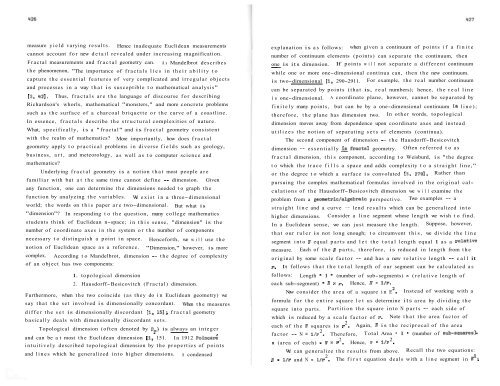Vol. 8 No 7 - Pi Mu Epsilon
Vol. 8 No 7 - Pi Mu Epsilon
Vol. 8 No 7 - Pi Mu Epsilon
Create successful ePaper yourself
Turn your PDF publications into a flip-book with our unique Google optimized e-Paper software.
measure yield varying results. Hence inadequate Euclidean measurements<br />
cannot account for new detail revealed under increasing magnification.<br />
Fractal measurements and fractal geometry can. As Mandelbrot describes<br />
the phenomenon, "The importance of fractals lies in their ability to<br />
capture the essential features of very complicated and irregular objects<br />
and processes in a way that is susceptible to mathematical analysis"<br />
[3, 421. Thus, fractals are the language of discourse for describing<br />
Richardson's whorls, mathematical "monsters," and more concrete problems<br />
such as the surface of a charcoal briquette or the curve of a coastline.<br />
In essence, fractals describe the structural complexities of nature.<br />
What, specifically, is a "fractal" and is fractal geometry consistent<br />
with the realm of mathematics? More importantly, how does fractal<br />
geometry apply to practical problems in diverse fields such as geology,<br />
business, art, and meteorology, as well as to computer science and<br />
mathematics?<br />
Underlying fractal geometry is a notion that most people are<br />
familiar with but at the same time cannot define -- dimension. Given<br />
any function, one can determine the dimensions needed to graph the<br />
function by analyzing the variables. We exist in a three-dimensional<br />
world; the words on this paper are two-dimensional. But what is<br />
"dimension"? In responding to the question, many college mathematics<br />
students think of Euclidean n-space; in this sense, "dimension" is the<br />
number of coordinate axes in the system or the number of components<br />
necessary to distinguish a point in space. Henceforth, we will use the<br />
notion of Euclidean space as a reference. "Dimension," however, is more<br />
complex. According to Mandelbrot, dimension -- the degree of complexity<br />
of an object has two components:<br />
1. topological dimension<br />
2. Hausdorff-Besicovitch (Fractal) dimension.<br />
Furthermore, when the two coincide (as they do in Euclidean geometry) we<br />
say that the set involved is dimensionally concordant. When the measures<br />
differ the set is dimensionally discordant [I, 151; fractal geometry<br />
basically deals with dimensionally discordant sets.<br />
Topological dimension (often denoted by DT) is always an integer<br />
and can be at most the Euclidean dimension [I, 151. In 1912 ~oincad<br />
intuitively described topological dimension by the properties of points<br />
and lines which he generalized into higher dimensions. A condensed<br />
explanation is as follows:<br />
when given a continuum of points if a finite<br />
number of continuum elements (points) can separate the continuum, then<br />
-<br />
one is its dimension.<br />
If points will not separate a different continuum<br />
while one or more one-dimensional continua can, then the new continuum.<br />
is two-dimensional [I, 290-2911. For example, the real number continuum<br />
can be separated by points (that is, real numbers); hence, the real line<br />
is one-dimensional.<br />
A coordinate plane, however, cannot be separated by<br />
finitely many points, but can be by a one-dimensional continuum (a line);<br />
therefore, the plane has dimension two.<br />
In other words, topological<br />
dimension moves away from dependence upon coordinate axes and instead<br />
utilizes the notion of separating sets of elements (continua).<br />
The second component of dimension -- the Hausdorff-Besicovitch<br />
dimension -- essentially &fractal geometry.<br />
Often referred to as<br />
fractal dimension, this component, according to Weisburd, is "the degree<br />
to which the trace fills a space and adds complexity to a straight line,"<br />
or the degree to which a surface is convoluted [5, 2791. Rather than<br />
pursuing the complex mathematical formulas involved in the original cal-<br />
culations of the Hausdorff-Besicovitch dimension we will examine the<br />
problem from a geometric/algebraic perspective. Two examples -- a<br />
straight line and a curve -- lend results which can be generalized into<br />
higher dimensions.<br />
Consider a line segment whose length we wish to find.<br />
In a Euclidean sense, we can just measure the length.<br />
Suppose, however,<br />
that our ruler is not long enough; to circumvent this, we divide the line<br />
segment into Ii equal parts and let the total length equal 1 as a relative<br />
measure.<br />
Each of the iV parts, therefore, is reduced in length from the<br />
original by some scale factor -- and has a new relative length -- call it<br />
r. It follows that the total length of our segment can be calculated as<br />
follows: Length = 1 = (number of sub-segments) x (relative length of<br />
each sub-segment) = H x r. Hence, Ii = 1/r.<br />
2<br />
<strong>No</strong>w consider the area of a square in E . Instead of working with a<br />
formula for the entire square let us determine its area by dividing the<br />
square into parts.<br />
Partition the square into N parts -- each side of<br />
which is reduced by a scale factor of r. <strong>No</strong>te that the area factor of<br />
2<br />
each of the N squares is r . Again, Ii is the reciprocal of the area<br />
2<br />
factor -- N = 1/r . Therefore, Total Area = 1 = (number of sub-squaresb<br />
2 2<br />
x (area of each) = Ii x r . Hence, H = 1/r .<br />
We can generalize the results from above. Recall the two equations:<br />
2<br />
iV = 1/r and N = 1/r . The first equation deals with a line segment in E';
















